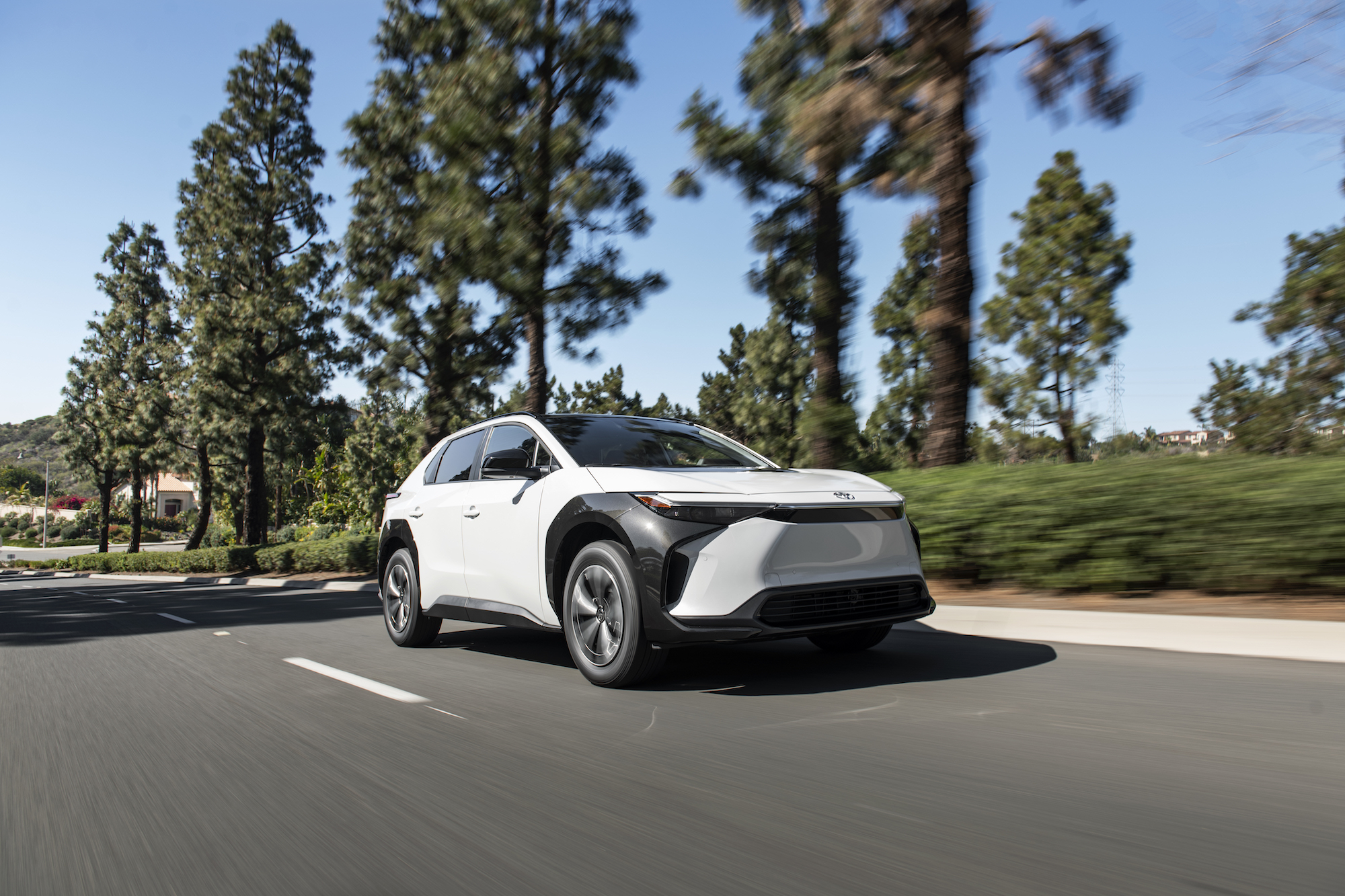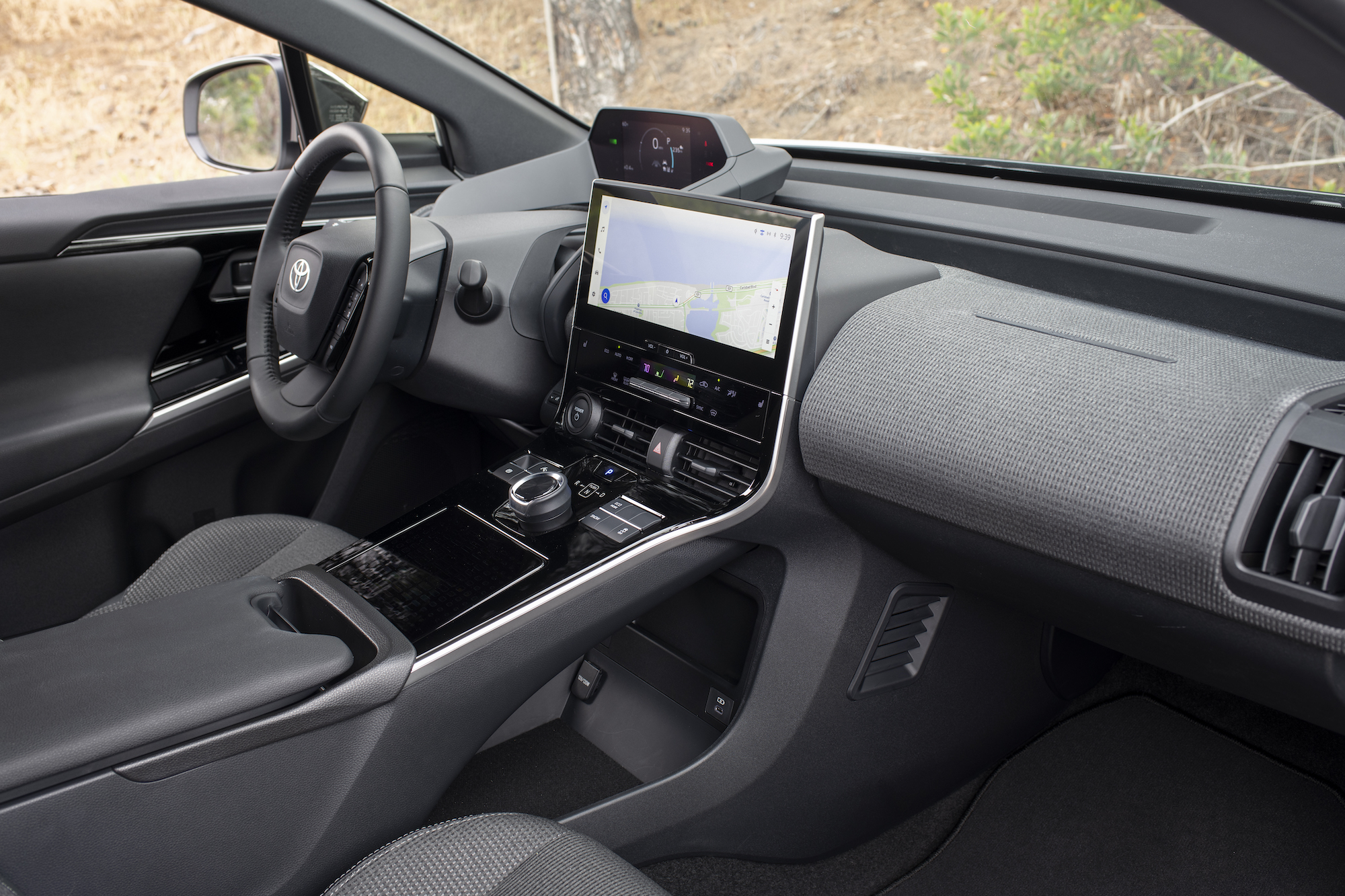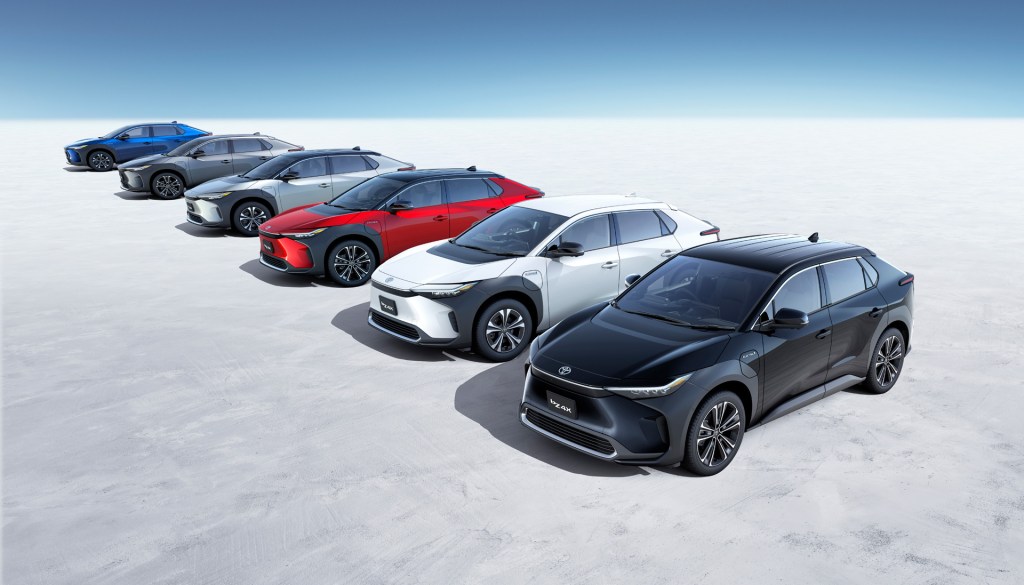Toyota isn’t the first automotive brand that pops to mind when it comes to battery electric vehicles.
Toyota might be the largest automaker in the world — reportedly selling more than 9.5 million vehicles globally and stealing the crown from Volkswagen Group — but the company has been markedly absent from the battery electric vehicle (BEV) space.
That is, until the 2023 Toyota bZ4X came along.
Toyota has shown off 30 different hybrid, battery-electric and alternative powertrain concepts in everything from a pickup to a sports car and has promised to deliver them all by 2030. The company has even committed a whooping $17.6 billion investment in battery technology and announced that it will build a battery plant in North Carolina.
For now, the 2023 Toyota bZ4X is the lone representative of the company’s EV plans — an awkwardly named crossover that raises some questions about what the company really believes to be the future of battery-electric vehicles and just how committed they are to the entire thing.
TechCrunch, along with other media, had a chance to get a first drive of the Toyota bZ4X. Here’s what we found.
Nuts and volts

The all-electric Toyota bZ4X is the fraternal twin to the Subaru Solterra; both vehicles were born out of a joint development project between the two companies. Toyota designed the battery architecture, body, and cabin, while Subaru handled the all-wheel-drive system.
The big difference between the two? For potential customers, it is going to be the cost. Subaru customers will still qualify for the $7,500 federal tax credit, while Toyota only has a few left for qualified buyers to use after most of the company’s incentives went to the popular Toyota Prius. Beyond that, the two vehicles are essentially the same, minus the name on the badge.
Toyota says that pricing for the 2023 Toyota bZ4X starts at $42,000 for the XLE model and $46,700 for the Limited models, plus a $2,000 addition to each if you want all-wheel drive, plus a delivery fee of $1,215. All in you’re looking at a price tag that’s just $5 shy of $50,000 on the all-wheel-drive version before you add any packages that include an upgraded stereo, split rear spoiler or the better looking two-tone exterior colors. That’s a lot of money for a crossover buyer, and after spending a short three hours tooling around Encinitas in a pair of prototype Toyota bZ4X crossovers, in front-wheel and all-wheel-drive configuration, there’s not a truly compelling reason to shell out that much money for the version with the Toyota badge. I’ll have a second opportunity to spend a full week in the bZ4X in the next month to learn if spending more time in it might change my mind.
The front-wheel-drive XLE model puts out 201 horsepower and 196 lb-ft of torque and, according to Toyota will go from zero to 60 miles per hour in 7.1 seconds. That’s on par with most gasoline-powered crossovers on the road today. It’s neither impressive nor disappointing — but solidly average. Toyota says that the bZ4X XLE with front-wheel drive will get an EPA estimated 252 miles of range, which is the most of either variant. Again, a solidly average rating.
When I hopped into the car in the morning, I started with an impressive 294 miles of range on the odometer. After an hour and a half of stop-and-go traffic and a quick jaunt down the freeway to test the driver assistance systems (ADAS), I landed back at the hotel with an estimated 200 miles of range remaining, which is more than sufficient given the weather, traffic conditions and the way I drove.
When Toyota launched the bZ4X at the LA Auto Show last year, the company said it would reach 300 miles of range in the front-wheel-drive model.
As the bZ4X comes to market, those EPA estimates put it just shy of that target, yet still well within the long-range estimate (252 miles of range in the front-wheel-drive XLE version and 222 miles for the Limited all-wheel-drive version.)
That’s not unheard of in automotive circles since the testing process for vehicle range differs from country to country, and many manufacturers, like Toyota, base estimates on their home country’s testing processes, in this case, Japan.
It’s important to note, however, that the EPA range is less than some of the other electric vehicles in the competitive set, like the Hyundai Ioniq 5, Kia EV6, Tesla Model Y and Chevrolet Bolt EV.
Toyota spokespeople at the event said that both the front-wheel and all-wheel-drive versions of the bZ4X will charge from “low to 80% within an hour” on DC Fast charging.
More concretely, the company says that a 2023 bZ4X all-wheel-drive version will add 90 miles of range in 30 minutes. The front-wheel-drive version will add 180 miles in 30 minutes, according to Toyota. That’s stacks up with competitors like the Chevy Bolt, which can add up to 100 miles in about 30 minutes of charging on a DC Fast charger.
The spec sheet provided by Toyota shows that the all-wheel-drive version of the bZ4X is capped at 100 kW of maximum charging input while the front-wheel-drive version is capped at 150 kW. That’s because, according to Toyota, the two batteries are made by different suppliers: The front-wheel-drive version is made by PPES and the all-wheel-drive version is made by CATL. That means that the all-wheel-drive version will charge slightly slower than the front-wheel-drive version at maximum charge. The bZX4 comes with a standard Level 1 charging cable. Again, all this is solidly middling.
We’ll have to wait and see if Toyota customers will be satisfied with the battery choices and range offered in the bZ4X.
Who is the Toyota bZ4X for?
Toyota says that these battery and architecture design decisions were made based on the preferences of their current customer base. As Lisa Materazzo, the group vice president of marketing at Toyota Motor North America said during her presentation at the event, “Simply put this vehicle is well positioned to be a success because it offers what customers expect in a BEV.” Later in the presentation, she continued, “We believe that bZ4X will be successful because it is purpose-built for our customers.” This raises some questions: Who is going to shell out $50,000 for a Toyota that’s rather meh?
While the bZ4X isn’t Toyota’s very first production, all-electric crossover (they did make an all-electric RAV4 from 1997 to 2003 to comply with California’s zero-emissions mandates), it’s the first one that Toyota is planning to sell through “normal distribution and normal sales process,” according to Materazzo. According to Toyota, the bZ4X will be available to buy in ZEV states this month, followed by a 50-state rollout in the fall of this year.
No matter what Elon Musk promises (and doesn’t deliver on) it’s not likely that you’ll ever be able to buy an EV for less than $40,000. The average transaction price of a new ICE-engined vehicle is currently hovering around $47,000 as of March 2022, according to AutoTrader, thanks to a variety of factors including supply chain issues and chip shortages.
While it might seem that the target demographic for the bZ4X would be RAV4 and RAV4 Prime buyers, the $50,000-plus price tag for the all-electric ute may keep many of those customers away. Considering that the average household income for a RAV4 household is around $86,000 a year, RAV4 buyers are unlikely to make the transition to an all-electric crossover.
So perhaps the RAV4 buyer isn’t the target buyer. What about Prius Prime customers? The average income of Prius and Prius Prime owners hovers just under $100,000 a year, which would make a 2023 bZ4X an attainable purchase. But will Prius owners who love their strangely shaped, fuel-efficient hybrid cars decide to abandon their ways and hop into an all-electric crossover? Probably not, though Toyota representatives said during the presentation that their target customer is a family with an income of more than $100,000. So who is this vehicle really for?

Then there’s the home charging installation (a cost of around $600-$2,000) that Toyota said it will allow buyers of the 2023 bZ4X to roll into their car payment. That’s convenient (even if it isn’t the best financial decision a customer can make) considering that one of the best places to charge your EV is at home. But, it’s important to note that other automakers like Chevrolet offer to cover the costs of installing a level 2 charger at home with the purchase or lease of a new Bolt.
Toyota says that in its first year, it’s targeting around 7,000 projected sales for the bZ4X. For context, Toyota sold more than 300,000 Camrys in 2021 alone. Such a small number of BEVs won’t dent the environmental impact those 300,000 Camrys have. The company expects around 35% of the bZ4X sales to be XLE trims and 65% to be Limited, with a 40/60 split between front-wheel-drive and all-wheel-drive models. Even if Toyota is marketing itself as moving into the BEV space, it’s clearly doing it in very limited volumes and with very limited incentives for both current and potential Toyota buyers.
Toyota slow roll into BEVs
Toyota is currently the largest auto manufacturer in the world and sells everything from ICE-engined vehicles to electrics, but its all-electric strategy has been slow to take shape, compared to other automakers like GM, Hyundai, Kia, Volkswagen, Audi and others.
Toyota’s top executive Akio Toyoda, has, in the past, been outspoken about his concerns around battery-electric vehicles (while spreading false information using the rhetoric that oil companies use). In December of 2020, during his annual year-end address at the Japan Automobile Manufacturers Association, Toyoda criticized EVs as being “overhyped” according to the Wall Street Journal and said that the transition from gasoline to electric cars could cause a loss of millions of jobs and cause the collapse of the car industry. At the time, his comments were specifically directed at the Japanese government, which was still considering banning the sale of gasoline vehicles by mid-2030, following similar bans in places like California, Quebec and Washington state. In spite of Toyoda’s comments, the ban in Japan later passed, though it left room for hybrids to continue to be sold.
More recently, Toyota also threatened to pull out of U.K. manufacturing over net-zero plans for the country, according to the Times of London. At the heart of the issue is the U.K.’s green mandates, which Toyota wants to see “watered down,” so it won’t have to pay significant penalties if it fails to reach the country’s requirements for the number of battery and hybrid vehicles sales.
While vociferously resisting the much-touted transition to battery-electric cars may seem like a strange strategy for a company like Toyota, a closer look indicates that some of it is well-founded considering the limited resources the world can produce to create enough battery-electric vehicles.
At the same time, it’s important to note that a lot of the noise Toyota is making around battery-electric vehicles is mostly marketing.
The company continues to market its “Beyond Zero” (which is where the bZ nomenclature comes from) plans and has also tried to get alternative fuel vehicles into consumers’ hands, like the very good hydrogen-hybrid-powered Toyota Mirai. Toyota knows and recognizes that there’s not enough lithium in the world to replace all the ICE engines in its customers’ hands. Battery-electric vehicles, in their current form (powered by lithium-ion batteries), are simply not a viable alternative to replace all of the ICE-powered vehicles on the road today, let alone replace just those currently owned by Toyota customers.
Which is why the 2023 Toyota bZ4X makes sense. The vehicle offers a way for Toyota consumers to get into an all-electric crossover built by a company known for reliability and safety, while Toyota continues to leave room for the development and adoption of alternative powertrains, which won’t require the consumption of all the rare-earth elements in the world and allows the company to meet the increasing worldwide pressure to become more green.
But is the Toyota bZ4X a compelling enough product to get people into the company’s first battery-electric vehicle? On first drive: Not really. Between the cost, the architecture and the mixed messages on the future of alternative powertrains in Toyota vehicles from the very top levels of the company, it seems Toyota is making more of a marketing play with the bZ4X than anything. We’ll have to wait and see if consumers are willing to buy into that marketing message with their hard-earned cash.































Comment